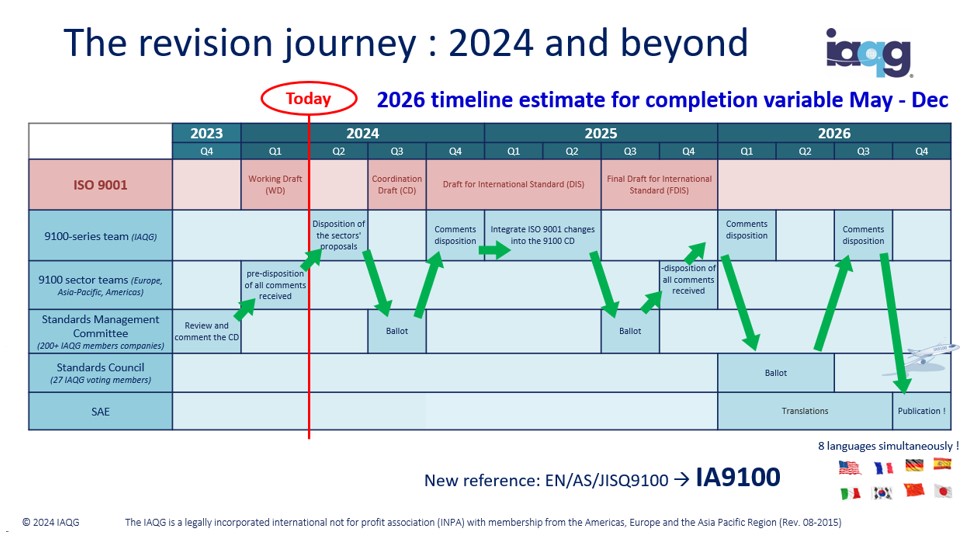Status of the Development of IA9100, Quality Management Systems – Requirements for Aviation, Space and Defense Organizations
Contributed by Jeannette Plante, NASA Quality Assurance Program Executive, (retired)
Looking at the title of this article, one might believe there is a typo in the document number. NASA adopted AS9100, Quality Management Systems – Requirements for Aviation, Space, and Defense Organizations into its quality policy in 2005 and has continued its use in the quality policy baseline through its last D revision that occurred in 2016.
In 2022, the International Aerospace Quality Group (IAQG), owner of the AS9100 content, entered into a publication and distribution agreement with SAE International to streamline those processes across the different international sectors and translation languages. As a result, all new IAQG documents and revisions will be assigned the new IAQG prefix “IA.” Only in limited cases will documents retain an AS prefix and a sector-level numbering scheme. With this agreement now in place and AS9100’s five-year update schedule in full swing, its next revision will result in renumbering it to IA9100.
AS9100’s update started in the third quarter of 2021 in anticipation of a release in 2024. This schedule was contingent on the five-year revision schedule for the International Organization for Standardization (ISO) 9001, Quality Management Systems Requirements. AS9100 consists of a combination of copyrighted ISO 9001 text with additional text added in bold italics that is relevant to the aerospace industry. This intertwining of the AS9100 content with ISO 9001 requires IAQG to stay logistically aligned with ISO 9001 updates for publication efficiency and reduced confusion.
In the interest of the optimal use of the available review schedule, the IAQG kicked off revision activities while waiting to hear whether ISO would choose to revise ISO 9001 or simply reconfirm it with no changes. IAQG’s first preparatory actions were to invite sector teams to recommend significant topics that should be addressed in the revision. These topics were vetted and dispositioned both at the sector levels (Americas, Asia Pacific, Europe) and at the combined IAQG level.
Fourteen themes were identified: Advanced Product Quality Planning (APQP), remote surveillance, product safety, Human Factors, cyber/data security, counterfeit terminology, culture/ethics, process terminology, risks, information security, terminology and formatting, Foreign Object Debris, sub-tier supplier control, and transfer of work. During the IAQG biannual Congress in Brussels in April 2023, these themes were debated in an open meeting. Over the next several months, a small writing team created a draft document based on the recommendations.
At the subsequent biannual IAQG meeting in San Francisco in October 2023, the IAQG shared ISO’s decisions regarding its revision schedule. ISO had decided to make some changes and expected to have a version that IAQG could use with low rework risk by the end of 2024. This pushes the IA9100 publication estimate to the fourth quarter of 2026. Rather than stand down for a year, the IAQG decided to continue with its coordination schedule and released the first draft of IA9100, using existing ISO 9001 content, in November 2023.
The sectors reviewed the November 2023 draft and consolidated 388 comments. Between December 2023 and March 2024, the sector teams reviewed and assigned the dispositions. The Americas team completed their dispositions at the biannual American Aerospace Quality Group (AAQG) meeting in Melbourne, Florida, in March. These dispositions will be sent to the IAQG and combined with those from the other two sectors and reviewed at the IAQG biannual Congress in Brussels in April.
Themes from the Americas’ dispositions included:
- Concerns about notes being turned into requirements that were overly burdensome or difficult to implement. A notable example relates to sub-tier supplier controls.
- General disagreement to add requirements related to culture and ethics as they are not uniformly interpreted or practical for auditing.
- The use of the terms “as appropriate” and “as applicable” when referring to requirements is found to be confusing and is a symptom of a lack of clarity in AS9100 about tailoring rules.
- Topics are touched on but there is no pointer in the paragraph about extensive preexisting and supporting standards (e.g., information security, APQP, counterfeit avoidance, Human Factors). Though this expands the document’s scope, it also oversimplifies the added topics.
- An urgency to keep the concept of product safety separate from key characteristics that are not necessarily tied to safety.
- Agreement to broaden the counterfeit item definition and seek alignment with the preexisting standards’ definitions (though they were found to be inconsistent).
- Disagreement to include business continuity and product line capacity as Risk Management items.
- Disagreement to include Human Factors topics, as Human Factors has a dedicated community within aerospace and defense and sustain its own standards and training.
- Agreement that a “location” for finding calibrated equipment can be an identified user.
- Agreement that a process can be used to verify the validity of material test reports rather than requiring 100% of those reports to be validated.
Below is a graphic to communicate the current IA9100 revision schedule. When the coordination draft becomes available, the NASA Office of Safety and Mission Assurance will invite NASA centers to submit comments for consolidation and submission to the IAQG.
